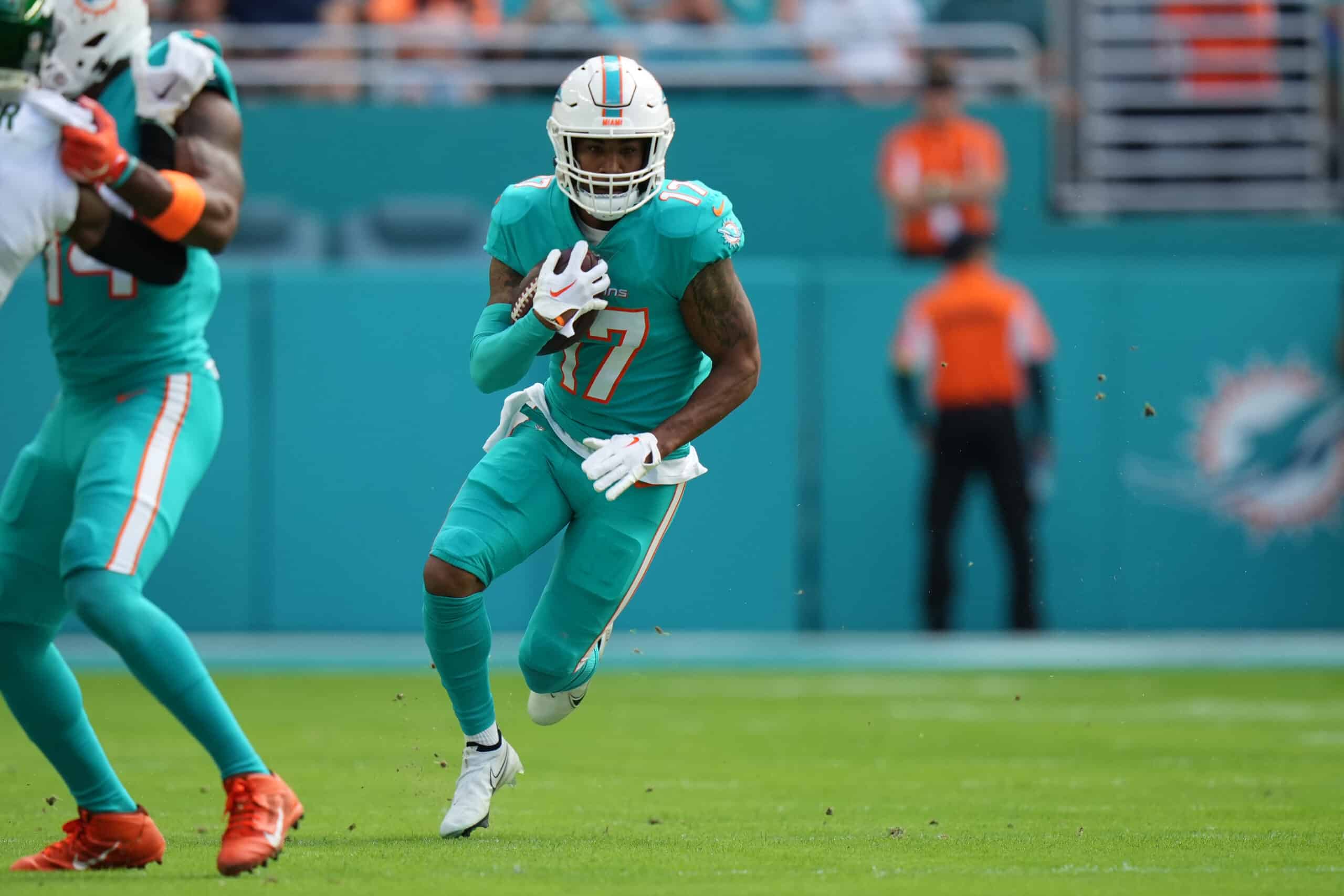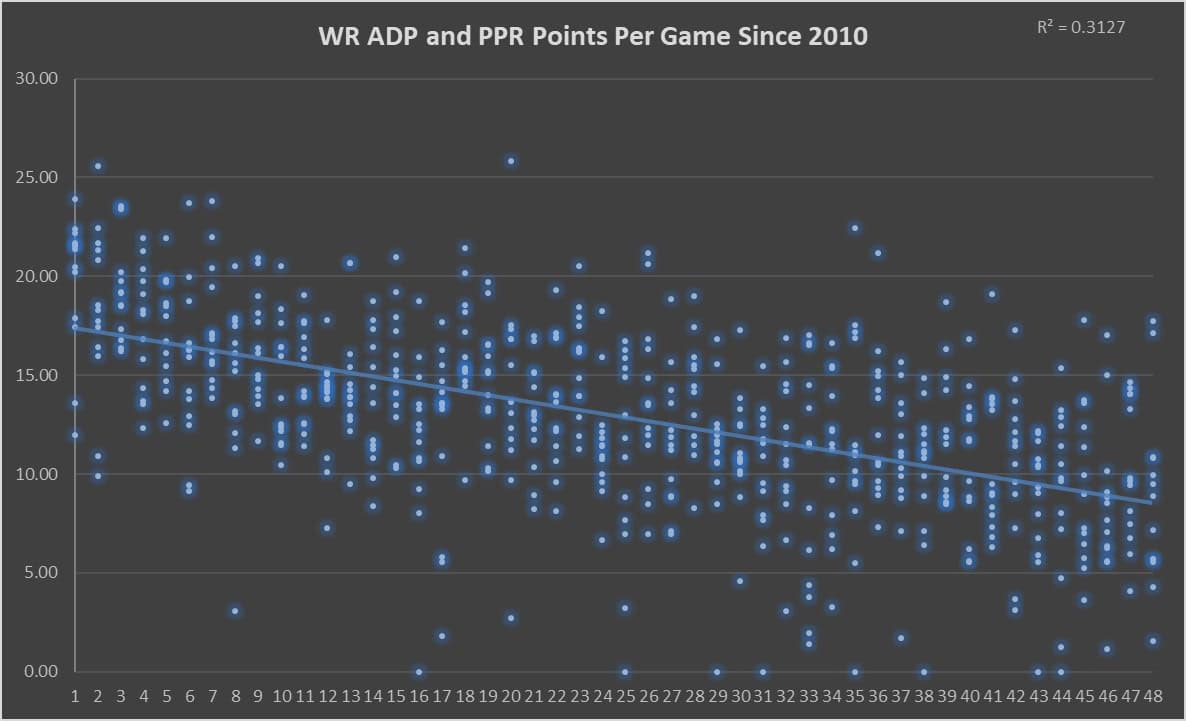- 41 wide receivers have averaged 20 or more PPR points per game since 2010. 30 of those seasons came from wide receivers selected in the top 10 at the position.
- WR1 options have averaged more overall points and have produced a higher rate of front-end scoring seasons than RB1 picks.
- Only 12.5% of all of the WR1 scoring seasons since 2010 have come from a player who also had a teammate being selected as a top 12 receiver.
As we prepare for our 2024 fantasy drafts, let's dive into the recent history of average draft positions to pull away any ongoing trends or pitfalls.
We have nearly eight full months to prepare for the draft every year, but how good are we at setting the market for the season?
We are looking to hash that out here, continuing with the wide receivers.
Wide Receiver Fantasy Related Articles:
- Wide Receiver Tiers
- Wide Receiver Rankings
- Wide Receiver Trends
- Red Zone Points vs Expectations: Wide Receiver
The correlation between average draft position and points per game for wide receivers is just a tick below the running back position but much stronger than quarterback.
The first thing that stands out when diagnosing the image above is that the crux of elite seasons from wideouts was often attached to front-end draft capital, similar to running backs.
41 wide receivers have averaged 20 or more PPR points per game since 2010.
30 of those seasons came from wide receivers selected in the top 10 at the position.
Only six were selected at WR20 or lower with two outside the top 24.
23 of those seasons came from wideouts selected as WR6 or higher.
Not pictured due to WR67 ADP, but Odell Beckham in 2014 was the only season averaging 20-plus points per game who was selected outside of the top 48.
In 2023, we had five receivers who averaged 20-plus points. Keenan Allen (WR18) was the only one not selected as a WR1.
We have talked about the top picks at every position so far, and wide receiver has the highest actual true hit rate for WR1 options ending up leading their position in points per game despite the overall lowered correlation of the position itself.
The element that hurts the overall correlation for wide receivers is that there has been more variance with how we have done year over year.
If you go back to the quarterback and running back posts, we ran into issues setting those markets last season.
We were stronger drafting wide receivers despite the down year of offensive production.
Don't miss out on the best fantasy football coverage in the business
Like the NFL, fantasy football never sleeps.
Best ball season is in full swing, and traditional drafts are right around the corner.
Sharp Football has everything you need to prepare for both in our Fantasy Football Draft Kit, powered by premier fantasy football analyst Rich Hribar.
Save more by bundling the Draft Kit with our in-season fantasy package that features Rich's comprehensive “Worksheet” preview of every game, every week of the NFL season.
Click here for more information about our fantasy coverage!
Top-48 WR in ADP & Correlation to PPR Points Per Game Since 2010
| Year | Top-48 | Top-36 | Top-24 | Top-12 |
|---|---|---|---|---|
| 2023 | 0.5724 | 0.3474 | 0.2855 | 0.1971 |
| 2022 | 0.4757 | 0.5226 | 0.5936 | 0.5424 |
| 2021 | 0.1901 | 0.1418 | 0.0368 | 0.4784 |
| 2020 | 0.2704 | 0.2006 | 0.0583 | 0.1635 |
| 2019 | 0.3534 | 0.2842 | 0.0768 | 0.1866 |
| 2018 | 0.5301 | 0.3121 | 0.6353 | 0.2481 |
| 2017 | 0.3021 | 0.3061 | 0.1098 | 0.3961 |
| 2016 | 0.2181 | 0.2243 | 0.1513 | 0.1072 |
| 2015 | 0.2418 | 0.1637 | 0.0685 | 0.1622 |
| 2014 | 0.2627 | 0.1621 | 0.2971 | 0.2441 |
| 2013 | 0.3085 | 0.2644 | 0.2499 | 0.5713 |
| 2012 | 0.2799 | 0.2651 | 0.1552 | 0.1198 |
| 2011 | 0.3466 | 0.3044 | 0.1796 | 0.3891 |
| 2010 | 0.3275 | 0.3168 | 0.1925 | 0.3687 |
Things were solid overall last year, but just like quarterback and running back, there was a lower correlation at the top of drafts compared to recent seasons.
After two strong years drafting WR1 options, we ran into volatility last season.
The tippy top was fine, but things fell apart at the lower-end WR1 range with Cooper Kupp, Davante Adams, Garrett Wilson, Jaylen Waddle, and Chris Olave failing to meet their draft capital.
Injuries have been an issue for the WR1 overall in recent seasons.
Over the past four years, Justin Jefferson (10 games played in 2023), Kupp (nine games played in 2022), and Michael Thomas (seven games played in 2020) all missed significant chunks of those seasons.
WRs vs. RBs
One of the biggest dilemmas drafters have is when to target wide receivers and running backs compared to their spots within the position.
Your draft room will dictate the costs of each position, but from an arbitrary stance, we can go under the hood to provide some light on how each level of the position performs versus its counterpart.
| POS | Match+ | Top 12% | Top 6% | PPG |
|---|---|---|---|---|
| WR1 | 50.6% | 50.6% | 33.9% | 16.5 |
| RB1 | 53.6% | 53.6% | 30.9% | 16.1 |
| WR2 | 54.5% | 25.6% | 10.3% | 13.8 |
| RB2 | 48.2% | 20.2% | 8.9% | 11.9 |
| WR3 | 40.4% | 13.5% | 3.9% | 11.5 |
| RB3 | 57.1% | 11.9% | 4.5% | 9.9 |
| WR4 | 44.2% | 5.1% | 1.3% | 9.9 |
| RB4 | 59.5% | 8.3% | 2.4% | 8.2 |
RB1 selections have edged top wideouts in justifying their draft cost.
Even though last season provided two of the largest late-round running back hits in Raheem Mostert and Kyren Williams, landing a front-end running back has more than less been a “pay to play” position when attempting to land a difference maker.
When you pair those edges with the support that an elite running back usually carries more positional leverage than an elite wide receiver, there is a strong reason why top running backs should be valued highly, even if they are drying up as a fantasy resource.
In current drafts, that is a reason why gamers are still jamming in Bijan Robinson and Breece Hall among the front-end wideouts.
Taking running backs early still works in fantasy football if you land the elusive three-down asset because it targets the part of the draft where the gap between running backs and wide receivers has historically been the tightest.
That said, WR1 options have averaged more overall points and have produced a higher rate of front-end scoring seasons than RB1 picks.
When we get into the WR2 level of required draft capital, WR2 (WRs 13-24) options are the most stable buys in matching their cost out of any subset of wide receivers.
Compared to their RB2 peers, they are just better in every department.
This aligns with the “dead zone” we discussed yesterday in the running back post.
This is where you should be pushing wide receivers over running backs.
If you are an early-round running back drafter, you will be guided here naturally.
If you started WR-heavy, you want to stay on that path at this junction of drafts even if you are pressured into believing that running backs are drying up.
The elite options aren’t drying up. They already have.
When you get to the WR3 and WR4 sections of the draft versus their running back counterparts, we start to see the running backs begin to match their positional ADP more than the wideouts.
At the WR3 level, there is more fragility meeting cost within the position, but those WR3 options still produce more points scored and have hit a higher rate of top-12 seasons (although the RB3 group has hit a higher ceiling rate of top-six scoring campaigns).
When reaching the WR4 level of drafts, things start to pivot back to running backs in hit rate areas despite lagging in overall points per game and games missed.
This entire section puts a bow on how I most often approach drafting, although there is no shortage of ways to win a league.
It also highlights how to handle positions within the ever-changing draft costs year-over-year.
Just because running backs are going later as a group in 2024, you still apply the tiers to the current market within each position.
This season, we have the WR3 group being selected among the RB2 tier in fantasy drafts, which appears to be an overcorrection.
Despite the RB2 group looking significantly weaker than the wide receivers in the same bucket at wideout, RB2s in ADP have outperformed WR3 picks in every department.
If your draft room is pushing secondary running backs down the board, keep tabs on those cutoffs.
I do not want to be the gamer making picks such as Jayden Reed, Christian Kirk, or Calvin Ridley versus players such as Najee Harris or James Conner.
Are Discounted WR1s A Value?
One thing gamers say in drafts when selecting a wide receiver in the middle-to-late portions of drafts is, “I am getting the WR1 on his team.”
Is there merit to that?
In our ADP sample since 2010, there have been 169 wide receivers who were the first receiver selected on their team and were also outside of the top 24 in ADP at the position.
Only 40.2% of those wideouts matched their ADP, slightly below the base rate of the position in those areas of the drafts meeting their draft capital.
Among that same group, just 18 of those players turned in a WR1 scoring season and just 23.1% have finished the season as a WR2 or better.
Comparing that group to the field of wide receivers selected outside of the top 24, it has been tight between WR1 picks and those who were WR2 or lower picks from their team.
18 of the 34 WR1 scoring hits from that group were the first receivers selected from their team.
We had one last season with Nico Collins.
So, WR1 picks have had a slightly better edge in turning in a high-scoring campaign than WR2 or later picks on rosters.
However, things take a significant turn pushing things and looking at wideouts who finished inside the top 24 despite having a lower draft cost.
There have been 94 seasons of that occurring in our sample.
Only 39 (41.5%) were the first wide receiver picked on their team.
In 2023, seven wide receivers fit this mold. Collins and Adam Thielen were the first receivers picked from their teams. Both were picked outside of the top 48 on average.
This season, the team WR1 picks going in the WR3 range or later are Zay Flowers, George Pickens (maybe pending Brandon Aiyuk), Christian Kirk, Terry McLaurin, Rashee Rice, Calvin Ridley, Jayden Reed, Diontae Johnson, Ladd McConkey, Keon Coleman, and Courtland Sutton.
Draft Young Players: Part 2,000
Sticking with the theme of wideouts turning in productive seasons over draft capital, among those 94 seasons in which a receiver finished as a top-24 scorer despite being a lower pick, 35.1% of those come from players in only the first two seasons of their career.
55% were on their rookie contracts.
One of the prevailing themes throughout this series has been targeting players on the front end of their career arcs if you are hunting for players to out-kick their draft cost.
Pairing that with the group above gives extra appeal to players such as Flowers, Pickens, Rice, Reed, McConkey, and Coleman.
Looking at wideouts that have been selected outside of the top 24 (WR2 range in drafts) based on year in the league, here are the hit rates for those receivers beating their ADP, and the rates on WR1, WR2, and WR3 seasons they have produced.
| Year | Match ADP% | WR3+ | WR2+ | WR1 |
|---|---|---|---|---|
| 1 | 47.6% | 32.9% | 15.9% | 3.7% |
| 2 | 41.5% | 36.2% | 21.3% | 5.3% |
| 3 | 33.9% | 26.8% | 12.5% | 3.6% |
| 4 | 34.5% | 20.7% | 12.1% | 1.7% |
| 5+ | 36.9% | 20.5% | 12.2% | 3.1% |
If value hunting, there is no tier to buy in on more than the year two wideout.
Typically, if a year-two player has a depressed ADP, it is because he did not blow up as a rookie.
Gamers are willing to take shots on rookies due to draft hype, but once a player provides meandering results, gamers have to be smacked in the face with results before believing that player could still be productive.
Wideouts in their second season do not match their ADP at a higher rate than rookie receivers, but they sweep the board in hit rates of top 36, top 24, and top 12 scoring campaigns from the group above.
If you were let down by Jaxon Smith-Njigba last year, this is the hope train for 2024 at a cheaper cost.
Players Attached to an Elite Wideout
One final area I want to hit on here is team WR2 or later who are attached to a front-end receiver.
We talked about this in a previous article, but offenses are finding better ways to funnel opportunities to their top targets.
We have seen the contingency upside players such as Jaylen Waddle and Tee Higgins have had when they have not played with Tyreek Hill and Ja’Marr Chase, but we also have seen the limitations those wideouts face when their alpha teammates are on the field.
Only 12.5% of all of the WR1 scoring seasons since 2010 have come from a player who also had a teammate being selected as a top 12 receiver.
We have 10 seasons in which two players from the same team were being selected as a WR1 in fantasy.
Only four times did both players end the season as a WR1.
There have been 47 wideouts in our sample selected as the top 24 wideouts attached to another WR1 teammate.
Just 12 of those players matched their ADP with 10 ending the season as a WR1 scorer.
Players like Waddle, DeVonta Smith, and Cooper Kupp meet those conditions this season.
Each still represents having contingency upside when their teammates are off the field but carries higher odds of being capped when those lead receivers are on the field.
Extending things out to later-round wide receivers, there have been 10 seasons in which a wideout selected outside of the top 24 and attached to a WR1 draft pick also closed that season as a WR1 scorer.
Only 10.9% of those receivers produced a top-24 scoring season.
Wrapping up the bullet points here:
- We were better at setting the overall WR market in 2023 than we were at QB or RB
- Draft WR2 options over RB2 options, but RB2 picks have stronger success rates than WR3 picks.
- WR3s are more volatile than RB3s but offer higher scoring ceilings and more baseline points per game.
- WR4 options still provide more scoring probability than RB4 options but lose in stability and spike-season hit rates.
- Selecting team WR1 options outside of the top 24 has had a low hit rate compared to team WR2 or later picks but edges that group in ceiling outcomes.
- When value hunting at the position, target players on their rookie contracts, especially in years 1-3 of their career.
- Do not aggressively pursue wide receivers attached to teammates who have a WR1 ADP.



















